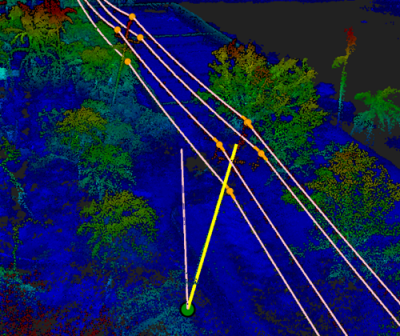With over 60 issued/allowed patents and nearly 200 total filings, Luminar is widely known for its 3D lidar data with camera-like high resolution and radar-like long range. Although the autonomous vehicle sensor and software company prioritizes performance over more affordable prices, Luminar will bring the latter to the table with a new lidar sensor, Iris.
Announced last month, Iris is a new kind of long-range lidar sensor, built from the chip level up. Iris is designed to meet the performance needs of autonomous vehicle manufacturers. Featuring a new form factor that can seamlessly integrate into vehicles, the company claims Iris is the first sensing platform to exceed the essential performance, safety, cost and auto-grade requirements needed to deliver Level 3 and 4 autonomy to consumers. With Iris, Luminar wants to deliver a comprehensive hardware-software architecture for perception of the driving environment, combining the company’s software products in sensor fusion, auto-calibration, tracking, object detection, classification and simulation.
When produced in commercial volumes, Iris is the sensing platform that can cost under $1,000 for consumer and commercial vehicles. Iris features alternative configurations for enabling better and safer assisted driving functionality at sub $500 pricing for larger programs. Moreover, Austin Russell, founder and CEO of Luminar, told SPAR 3D that low cost and better driving are crucial.
“With this, we are delivering a comprehensive hardware-software architecture for perception of the driving environment, making it possible for any car to have autonomy.”
Luminar has been able to lower the cost of its sensors by lowering the overall cost of building the chip to $3, according to Russell. The unit only requires the use of one laser and one receiver pair, which also keeps costs down. Rather than using add-on solutions that work with off-the-shelf components, Luminar has taken a different approach when building its own hardware. Russell is critical of the industry’s overall approach to building autonomous vehicles.
“The reality is that the industry has, in large part, still vastly struggled to be able to even meet the table stakes required. That means meeting the performance and safety specifications, much less building something that can actually be an auto-grade, cost-effective scalable sensor that’s going into production vehicles.”
Furthermore, Luminar has recently received a $100M investment from top institutional investors, bringing its total amount to $250M. According to Russell, this will help accelerate the company’s foray into the consumer and commercial series production vehicle market with Iris.
Founded in 2012, Luminar is currently working with 12 of the world’s top 15 OEMs to deliver on the promise of safe and ubiquitous autonomous vehicles, including Toyota Research Institute (TRI), Volvo Cars and VW/Audi’s AID. The company is constantly forging ahead on technology, continually trying to improve it, hence why it is already on the seventh-generation chip, fourth-generation laser, fourth-generation receiver, and third-generation of scanner.
“It’s really important to be able to evolve the technology not just from an improvement standpoint, which we’re always constantly making with the latest generations of various sub-components within it, but in terms of just maturity,” said Russell.
“This spans from robustness to the manufacturing process, reliability to the repeatability of performance, etc. This just takes time to reach maturity. It’s also critical getting designed into these development fleet platforms so that programs can really start developing their software on top of it, and especially on a platform like ours that is ultimately evolving into series production. A key thing for them is seeing the maturing of the product and the company to a point where the technology can actually be put into real production vehicles. That’s not a trivial thing. And historically, no one has been able to put any of these types of lidar products into any production vehicle that can enable true autonomy. Nor has anyone historically actually had any type of roadmap to be able to successfully do that. That’s the direction that we’re headed down that we think Iris will be the game-changer for the industry.”
Additionally, Cornes, a company with more than 150 years of business and supply chain experience in Japan, is supporting Luminar’s global expansion into Asia. Also, Corning, one of the world’s leading innovators in materials science for industrial and scientific applications, including Corning Gorilla Glass, is working with Luminar to build lidar windows, among other optical components.
SPAR 3D: Looking back at when Luminar joined the lidar/automotive industries, how well do you think these industries have grown? What should be the focus, and what do you expect to happen in the future of these industries?
Austin Russell: We’re at a stage where everyone in the industry is hacking together Frankenstein solutions with off-the-shelf parts for their R&D programs, but to successfully achieve series production autonomy, hardware and software have to be seamlessly developed and integrated in tandem. With an overabundance of lidar R&D efforts out there today, we’re seeing some level of consolidation in the market as these outfits make easy and relatively cheap acquisition targets or intelligent acqui-hires. There are an abundance of R&D technologies that exist but don’t have a supply chain or scale yet figured out, nor the wide market traction required to gain platform wins. Consolidation will continue as the market converges on the requirements needed for high levels of autonomy.
The automotive companies are realizing that you only need to reinvent the wheel so many times. This is especially true for things that aren’t materialized. There have been huge efforts, large and small that have never been able to make it past that initial research phase. At the end of the day, it’s absolutely critical for these automakers to be able to work with someone that can be designed into their vehicle platforms. This is something that has a really high barrier to entry, but equivalently a really high barrier to exit.






